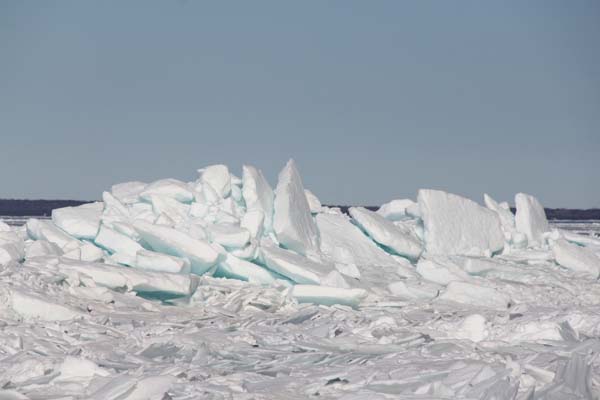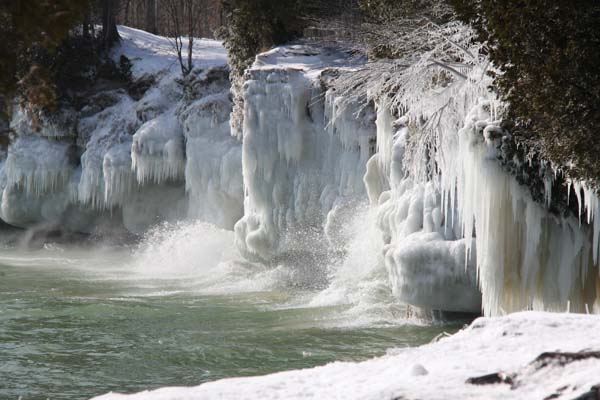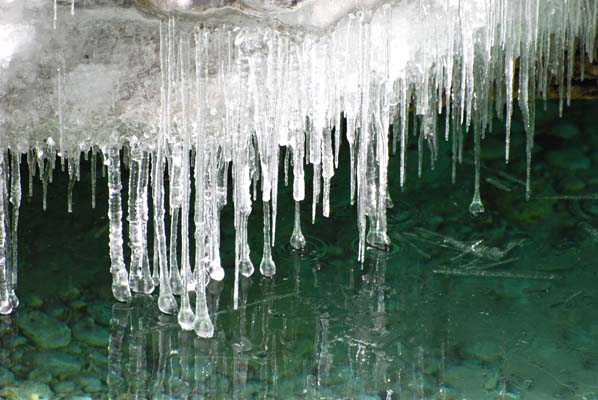
The Ice Experience in Door County
Published
Lake Michigan provides an ever-changing living-art exhibit in the winter with the formation of ice along the 300 miles of Door County shoreline. The visual landscapes are fantastic; the ice varies from crystal-clear — accenting the Caribbean green of the lake — to cool glacial blues. The ice also makes audible sounds, which change depending on the thickness of the ice and the direction and strength of the wind. Below the ice, waves echo through caverns and push delicate shards of glass-like ice rattling across rocks and wooshing back out. It’s a sight to see, and we’ve put together a list not to miss with safety tips to keep in mind as you explore Door County in the wintertime.
The Ice Shoves of Green Bay
On the western shoreline, you can find what are called "ice shoves." Because Green Bay completely freezes over with ice 2–3-feet thick, the surface continuously expands forcing large pieces of frozen ice up and onto shore. Some years, the combination of expanding ice and wind has seen shoves more than 10 feet high. These slow-forming structures have even crept onto shore far enough to cause damage to shoreline structures.

Eastern Icicles & Icy Shorelines
Over on the eastern shoreline, water along the edge of the lake and shallow bays freeze over, but bigger waves and currents keep ice from fully forming across the water. You can see shallow frozen bays near Baileys Harbor at Ridges Park and nearby Toft Point Nature Preserve, which connects to Moonlight Bay. Cana Island also provides wondrous, icy lake views.

The larger water activity on these shores can also create more interesting ice art. Near Cave Point County Park, you can see intricate icicle structures that are ever-changing depending on wind and current. Water splashes and sprays over the rocks, forming interesting layers of ice and stalactites. Head further south to Whitefish Dunes State Park and find a vast tumble of glittering ice formations along the beaches, which can be accessed through several hiking trails.

Inland Lakes
Inland lakes all freeze over, and many are used for ice skating and ice fishing. Europe Lake, Clark Lake and Mud Lake are all accessible during the winter for hiking, snowshoeing or view-gazing.
The Ice Harvest
The ice will always be a source of winter sights and activity, but not too long ago, ice in Green Bay was big business. Before refrigeration was invented in the 1920s, ice houses held large chunks of ice covered in sawdust, which would be sold to local residents, fishermen and grocers. See how the ice was harvested in our Historic Door County video.
Caution: How to Explore Ice Safely
The magnificent ice formations across Wisconsin draw thousands of visitors to the lakes and shores every season. There is no such thing as perfectly safe ice, and you can't judge its thickness simply by eyesight. Before you make your way to Door County to see the brilliant creations first-hand, review these safety tips from The Department of Natural Resources (DNR) and remain diligent on your journey.
While the DNR does not monitor ice conditions, the local bait shops, fishing clubs and resorts typically have the 411 on the ice. Once you know you're ready to explore, follow these safety tips from the DNR:
Dress warmly in layers.
Don't go alone; head out with friends or family.
Make sure someone knows where you are and when you are expected to return.
Don't travel in areas you are not familiar with and don't travel at night or during reduced visibility.
Avoid inlets, outlets or narrow that may have current that can thin the ice.
Look for clear ice, which is generally stronger than ice with snow on it or bubbles in it.
Carry some basic safety gear: ice claws or picks, a cellphone in a waterproof bag or case, a life jacket and a length of rope.
If you fall through the ice, remain calm and act quickly by following these instructions from the DNR:
Do not remove your winter clothing. Heavy clothes can trap air, which can help provide warmth and flotation. This is especially true in a snowmobile suit.
Go back toward the direction you came. That is probably where you will find the strongest ice — what lies ahead is unknown.
Place your hands and arms on the unbroken surface. This is where a pair of nails, sharpened screwdrivers or ice picks are handy in providing the extra traction you need to pull yourself up onto the ice.
Kick your feet and dig in your ice picks to work your way back onto the solid ice. If your clothes have trapped a lot of water, you may have to lift yourself partially out of the water on your elbows to let the water drain before starting forward.
Once back on the ice, don't try to stand up. Lie flat until you are completely out of the water, then roll away from the hole to keep your weight spread out. This may help prevent you from breaking through again.
Get to a warm, dry, sheltered area and warm yourself up immediately. In moderate to severe cases of cold-water hypothermia, you must seek medical attention. Cold blood trapped in your extremities can come rushing back to your heart after you begin to warm up. The shock of the chilled blood may cause ventricular fibrillation leading to a heart attack and death!
Sign up today!
Visit Door County virtually with monthly newsletter updates. Each issue is jam-packed with vacation ideas, special offers, recipes, festivals, events, and more.


